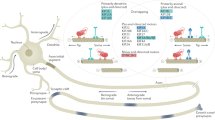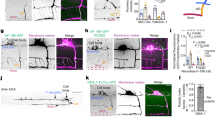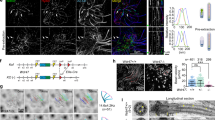Abstract
The polarized distribution of neuronal proteins to axons and dendrites relies on microtubule-binding proteins such as CRMP, directed motors such as the kinesin UNC-104 (Kif1A) and diffusion barriers such as ankyrin. The causative relationships among these molecules are unknown. We show here that Caenorhabditis elegans CRMP (UNC-33) acts early in neuronal development, together with ankyrin (UNC-44), to organize microtubule asymmetry and axon-dendrite sorting. In unc-33 and unc-44 mutants, axonal proteins were mislocalized to dendrites and vice versa, suggesting bidirectional failures of axon-dendrite identity. unc-44 directed UNC-33 localization to axons, where it was enriched in a region that resembled the axon initial segment. unc-33 and unc-44 were both required to establish the asymmetric dynamics of axonal and dendritic microtubules; in their absence, microtubules were disorganized, the axonal kinesin UNC-104 invaded dendrites, and inappropriate UNC-104 activity randomized axonal protein sorting. We suggest that UNC-44 and UNC-33 direct polarized sorting through their global effects on neuronal microtubule organization.
This is a preview of subscription content, access via your institution
Access options
Subscribe to this journal
Receive 12 print issues and online access
$209.00 per year
only $17.42 per issue
Buy this article
- Purchase on Springer Link
- Instant access to full article PDF
Prices may be subject to local taxes which are calculated during checkout








Similar content being viewed by others
References
Arimura, N. & Kaibuchi, K. Neuronal polarity: from extracellular signals to intracellular mechanisms. Nat. Rev. Neurosci. 8, 194–205 (2007).
Barnes, A.P. & Polleux, F. Establishment of axon-dendrite polarity in developing neurons. Annu. Rev. Neurosci. 32, 347–381 (2009).
Witte, H., Neukirchen, D. & Bradke, F. Microtubule stabilization specifies initial neuronal polarization. J. Cell Biol. 180, 619–632 (2008).
Li, W., Herman, R.K. & Shaw, J.E. Analysis of the Caenorhabditis elegans axonal guidance and outgrowth gene unc-33. Genetics 132, 675–689 (1992).
Kimura, T., Watanabe, H., Iwamatsu, A. & Kaibuchi, K. Tubulin and CRMP-2 complex is transported via Kinesin-1. J. Neurochem. 93, 1371–1382 (2005).
Inagaki, N. et al. CRMP-2 induces axons in cultured hippocampal neurons. Nat. Neurosci. 4, 781–782 (2001).
Fukata, Y. et al. CRMP-2 binds to tubulin heterodimers to promote microtubule assembly. Nat. Cell Biol. 4, 583–591 (2002).
Arimura, N. et al. Anterograde transport of TrkB in axons is mediated by direct interaction with Slp1 and Rab27. Dev. Cell 16, 675–686 (2009).
Kawano, Y. et al. CRMP-2 is involved in kinesin-1-dependent transport of the Sra-1/WAVE1 complex and axon formation. Mol. Cell. Biol. 25, 9920–9935 (2005).
Hirokawa, N. & Takemura, R. Molecular motors and mechanisms of directional transport in neurons. Nat. Rev. Neurosci. 6, 201–214 (2005).
Burton, P.R. & Paige, J.L. Polarity of axoplasmic microtubules in the olfactory nerve of the frog. Proc. Natl. Acad. Sci. USA 78, 3269–3273 (1981).
Heidemann, S.R., Landers, J.M. & Hamborg, M.A. Polarity orientation of axonal microtubules. J. Cell Biol. 91, 661–665 (1981).
Burton, P.R. Ultrastructure of the olfactory neuron of the bullfrog: the dendrite and its microtubules. J. Comp. Neurol. 242, 147–160 (1985).
Baas, P.W., Deitch, J.S., Black, M.M. & Banker, G.A. Polarity orientation of microtubules in hippocampal neurons: uniformity in the axon and nonuniformity in the dendrite. Proc. Natl. Acad. Sci. USA 85, 8335–8339 (1988).
Grubb, M.S. & Burrone, J. Building and maintaining the axon initial segment. Curr. Opin. Neurobiol. 20, 481–488 (2010).
Winckler, B., Forscher, P. & Mellman, I. A diffusion barrier maintains distribution of membrane proteins in polarized neurons. Nature 397, 698–701 (1999).
Jenkins, S.M. & Bennett, V. Ankyrin-G coordinates assembly of the spectrin-based membrane skeleton, voltage-gated sodium channels, and L1 CAMs at Purkinje neuron initial segments. J. Cell Biol. 155, 739–746 (2001).
Hedstrom, K.L., Ogawa, Y. & Rasband, M.N. AnkyrinG is required for maintenance of the axon initial segment and neuronal polarity. J. Cell Biol. 183, 635–640 (2008).
Song, A.H. et al. A selective filter for cytoplasmic transport at the axon initial segment. Cell 136, 1148–1160 (2009).
Sobotzik, J.M. et al. AnkyrinG is required to maintain axo-dendritic polarity in vivo. Proc. Natl. Acad. Sci. USA 106, 17564–17569 (2009).
Quinn, C.C. et al. TUC-4b, a novel TUC family variant, regulates neurite outgrowth and associates with vesicles in the growth cone. J. Neurosci. 23, 2815–2823 (2003).
Ogawa, Y. et al. Spectrins and ankyrinB constitute a specialized paranodal cytoskeleton. J. Neurosci. 26, 5230–5239 (2006).
Brot, S. et al. CRMP5 interacts with tubulin to inhibit neurite outgrowth, thereby modulating the function of CRMP2. J. Neurosci. 30, 10639–10654 (2010).
Hedgecock, E.M., Culotti, J.G., Thomson, J.N. & Perkins, L.A. Axonal guidance mutants of Caenorhabditis elegans identified by filling sensory neurons with fluorescein dyes. Dev. Biol. 111, 158–170 (1985).
Brenner, S. The genetics of Caenorhabditis elegans. Genetics 77, 71–94 (1974).
Otsuka, A.J. et al. An ankyrin-related gene (unc-44) is necessary for proper axonal guidance in Caenorhabditis elegans. J. Cell Biol. 129, 1081–1092 (1995).
Tsuboi, D., Hikita, T., Qadota, H., Amano, M. & Kaibuchi, K. Regulatory machinery of UNC-33 Ce-CRMP localization in neurites during neuronal development in Caenorhabditis elegans. J. Neurochem. 95, 1629–1641 (2005).
Albeg, A. et al. C. elegans multi-dendritic sensory neurons: morphology and function. Mol. Cell. Neurosci. 46, 308–317 (2011).
White, J.G., Southgate, E., Thomson, J.N. & Brenner, S. The structure of the nervous system of the nematode Caenorhabditis elegans. Phil. Trans. R. Soc. Lond. B 314, 1–340 (1986).
Treinin, M., Gillo, B., Liebman, L. & Chalfie, M. Two functionally dependent acetylcholine subunits are encoded in a single Caenorhabditis elegans operon. Proc. Natl. Acad. Sci. USA 95, 15492–15495 (1998).
Nonet, M.L. et al. Caenorhabditis elegans rab-3 mutant synapses exhibit impaired function and are partially depleted of vesicles. J. Neurosci. 17, 8061–8073 (1997).
Crump, J.G., Zhen, M., Jin, Y. & Bargmann, C.I. The SAD-1 kinase regulates presynaptic vesicle clustering and axon termination. Neuron 29, 115–129 (2001).
Yonekawa, Y. et al. Defect in synaptic vesicle precursor transport and neuronal cell death in KIF1A motor protein-deficient mice. J. Cell Biol. 141, 431–441 (1998).
Hall, D.H. & Hedgecock, E.M. Kinesin-related gene unc-104 is required for axonal transport of synaptic vesicles in C. elegans. Cell 65, 837–847 (1991).
Dwyer, N.D., Adler, C.E., Crump, J.G., L'Etoile, N.D. & Bargmann, C.I. Polarized dendritic transport and the AP-1 mu1 clathrin adaptor UNC-101 localize odorant receptors to olfactory cilia. Neuron 31, 277–287 (2001).
Zhou, H.M., Brust-Mascher, I. & Scholey, J.M. Direct visualization of the movement of the monomeric axonal transport motor UNC-104 along neuronal processes in living Caenorhabditis elegans. J. Neurosci. 21, 3749–3755 (2001).
Dwyer, N.D., Troemel, E.R., Sengupta, P. & Bargmann, C.I. Odorant receptor localization to olfactory cilia is mediated by ODR-4, a novel membrane-associated protein. Cell 93, 455–466 (1998).
Wolff, A. et al. Distribution of glutamylated alpha and beta-tubulin in mouse tissues using a specific monoclonal antibody, GT335. Eur. J. Cell Biol. 59, 425–432 (1992).
Siddiqui, S.S., Aamodt, E., Rastinejad, F. & Culotti, J. Anti-tubulin monoclonal antibodies that bind to specific neurons in Caenorhabditis elegans. J. Neurosci. 9, 2963–2972 (1989).
Mimori-Kiyosue, Y., Shiina, N. & Tsukita, S. The dynamic behavior of the APC-binding protein EB1 on the distal ends of microtubules. Curr. Biol. 10, 865–868 (2000).
Srayko, M., Kaya, A., Stamford, J. & Hyman, A.A. Identification and characterization of factors required for microtubule growth and nucleation in the early C. elegans embryo. Dev. Cell 9, 223–236 (2005).
Yi, J.J., Barnes, A.P., Hand, R., Polleux, F. & Ehlers, M.D. TGF-beta signaling specifies axons during brain development. Cell 142, 144–157 (2010).
Adler, C.E., Fetter, R.D. & Bargmann, C.I. UNC-6/Netrin induces neuronal asymmetry and defines the site of axon formation. Nat. Neurosci. 9, 511–518 (2006).
Ou, C.Y. et al. Two cyclin-dependent kinase pathways are essential for polarized trafficking of presynaptic components. Cell 141, 846–858 (2010).
Rolls, M.M. et al. Polarity and intracellular compartmentalization of Drosophila neurons. Neural Dev. 2, 7 (2007).
Meyrand, P., Weimann, J.M. & Marder, E. Multiple axonal spike initiation zones in a motor neuron: serotonin activation. J. Neurosci. 12, 2803–2812 (1992).
Palay, S.L., Sotelo, C., Peters, A. & Orkand, P.M. The axon hillock and the initial segment. J. Cell Biol. 38, 193–201 (1968).
Mello, C. & Fire, A. DNA transformation. Methods Cell Biol. 48, 451–482 (1995).
Wicks, S.R., Yeh, R.T., Gish, W.R., Waterston, R.H. & Plasterk, R.H. Rapid gene mapping in Caenorhabditis elegans using a high density polymorphism map. Nat. Genet. 28, 160–164 (2001).
Ruvkun, G. & Giusto, J. The Caenorhabditis elegans heterochronic gene lin-14 encodes a nuclear protein that forms a temporal developmental switch. Nature 338, 313–319 (1989).
Acknowledgements
We thank C. Ghenoiu, P. Nurse, Y. Saheki, S. Shaham, M. Tsunozaki, M. Heiman, A. Kelly, T. Starich and members of our labs for advice and comments on the manuscript, C. Janke (Institut Curie) and B. Edde (Universite Pierre et Marie Curie) for antibodies, and Y. Saheki (Rockefeller University) and the Caenorhabditis Genetics Center for strains. C.I.B. and K.S. are Investigators of the Howard Hughes Medical Institute. This work was supported by the Howard Hughes Medical Institute.
Author information
Authors and Affiliations
Contributions
T.A.M. designed, conducted and interpreted most experiments and wrote the paper; M.K., G.J.W., K.S., L.W. and J.E.S. conducted and interpreted individual experiments with unc-33 and unc-44 mutants; S.P.K. generated the UNC-104 antibody and helped design transport experiments; C.I.B. designed and interpreted experiments and wrote the paper.
Corresponding author
Ethics declarations
Competing interests
The authors declare no competing financial interests.
Supplementary information
Supplementary Text and Figures
Supplementary Figures 1–7 (PDF 2124 kb)
Supplementary Video 1
Movement of EBP-2::GFP puncta in axons of wild type sensory neurons. Cell bodies are to the right. Displayed at 10x speed. Scale bar, 5 μm. (MOV 108 kb)
Supplementary Video 2
Movement of EBP-2::GFP puncta in proximal dendrites of wild type sensory neurons. Distal dendrites are to the left; cell bodies are to the right. Displayed at 10x speed. Scale bar, 5 μm. (MOV 561 kb)
Supplementary Video 3
Movement of EBP-2::GFP puncta in distal dendrites of wild type sensory neurons. Cilia are to the left; cell bodies are to the right (neither is visible). Displayed at 10x speed. Scale bar, 5 μm. (MOV 159 kb)
Supplementary Video 4
Movement of EBP-2::GFP puncta in axons of unc-33(mn407) sensory neurons. Cell bodies are to the right. Displayed at 10x speed. Scale bar, 5 μm. (MOV 183 kb)
Supplementary Video 5
Movement of EBP-2::GFP puncta in proximal dendrites of unc-33(mn407) sensory neurons. Distal dendrites are to the left; cell bodies are to the right. Displayed at 10x speed. Scale bar, 5 μm. (MOV 200 kb)
Supplementary Video 6
Movement of EBP-2::GFP puncta in distal dendrites of unc-33(mn407) sensory neurons. Cilia are to the left; cell bodies are to the right (neither is visible). Displayed at 10x speed. Scale bar, 5 μm. (MOV 96 kb)
Rights and permissions
About this article
Cite this article
Maniar, T., Kaplan, M., Wang, G. et al. UNC-33 (CRMP) and ankyrin organize microtubules and localize kinesin to polarize axon-dendrite sorting. Nat Neurosci 15, 48–56 (2012). https://doi.org/10.1038/nn.2970
Received:
Accepted:
Published:
Issue Date:
DOI: https://doi.org/10.1038/nn.2970
This article is cited by
-
Deep learning-enabled analysis reveals distinct neuronal phenotypes induced by aging and cold-shock
BMC Biology (2020)
-
Atlastin-1 regulates morphology and function of endoplasmic reticulum in dendrites
Nature Communications (2019)
-
Disruption of the psychiatric risk gene Ankyrin 3 enhances microtubule dynamics through GSK3/CRMP2 signaling
Translational Psychiatry (2018)
-
Transcriptional regulation of CRMP5 controls neurite outgrowth through Sox5
Cellular and Molecular Life Sciences (2018)
-
The rise and fall of basal bodies in the nematode Caenorhabditis elegans
Cilia (2017)



